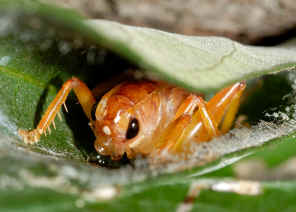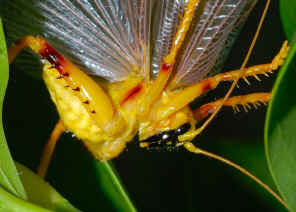|
| |
- This page contains pictures and information about Wood Crickets, Raspy
Crickets and
Leaf-rolling Crickets that we
found in the Brisbane area, Queensland, Australia.
-
 - Winged male
-
- This is a large insect family. Members in this family
Gryllacrididae, including late instars, males and females, will produce a
raspy sound when disturbed. All of them are active at night. They usually spend the
daytime in burrows or in leaves shelters. Both adults and nymphs produce silks
by their mouthparts. They lay silk to line burrows wall or hold
leaves together. Some build burrows or leaves retreats similar to those made by spiders.
-
- The above photo show the cricket trying to show
us that it is a spider. It is interesting to relate how the crickets
evolved this habit with their spider-nest looking retreat.
-



-
- Every evening Raspy Cricket wander and feed outside quite far away from
their retreat. They can recognise their own retreats and go back home
without problem. Recent studies show that they use pheromones to recognise
their way home.
-
- They are medium to very large in size and usually pale brown to dark brown in colours. Most of the adults are fully winged although some are wingless. They are robust
and generally with soft body. Their legs usually are not long, but strong and spiny.
As other crickets, they have very long antenna, usually longer than two
times of their body length. Notice that when they are resting in retreat,
their antenna are folded in circular manner around their body length. For those species that fully
winged, their front pair of wings, or tegmina are very soft. This character
distinguishes this family from the other cricket families.
-
- Most species in this family
Gryllacrididae are considered omnivorous (eat everything) although some
are carnivorous. Their mandibles are sharp and
elongated.
-
- When disturbed, the cricket inflates their abdomen and raise themselves with
some of the legs up right. It then repeatingly move the abdomen against the stationary
legs creating a low, raspy sound. At the same time it makes noise with the mandibles
and wings. If this cannot drive away the dangers, the activity becomes more vigorous.
-
- The
raspy sound seems to serve a defensive purpose only and not for communication.
The cannot listen to each other. The crickets, both male
and female, seems do not have any hearing organ.
-
- As other crickets, females in this family have long sword-like ovipositor.
-
-
- Striped Raspy Cricket, Tree Cricket

 - Paragryllacris combusta, nymph, adult female body length 50mm
- The 2nd photo shows the cricket feeding on nectar from the flowers of the Large
Bird-of-Paradise tree in our front yard. We took the pictures at night on OCT 2000. We noticed
that the cricket climbed up the same tree at the same time every night. It
did the same routine the following days, even we captured it once and put in a
jar. We watched it for a few hours then let it go. More information and pictures
please click on here.
-
-
- Spider Face Leaf Rolling Cricket

 - Nunkeria brochis, nymph, body length
30mm
adult body length 50mm
- Spider Face Leaf-rolling Cricket is
reddish brown to orange pale brown in colour with fully developed wings. It
has
very long antenna, all legs are spiny. The median ocellus of the
cricket is very large. The cricket hide in nest on tree
during the day. Their nest is usually two board leaves hold together by
silky material. The Cricket has a dark face pattern resemble the spider's
face, i.e., a pair of large fangs, group of compound eyes. It mimics spider
behaviour as well. Details please check this page.
-
-
- Three-eyed Leaf-rolling Cricket


- Xiphogryllacris orthoxipha, last instars, body length 20mm
- This Leaf Rolling Cricket has the very large median ocellus which is as
large as its compound eyes. So we call it Three-eyed Leaf Rolling Cricket.
Unlike the two other species we listed above, there is no any dark markings on
its face. Please check this page
for more information.
-
-
- Pale-brown Leaf-rolling Cricket

 - ? Apotrechus sp., body length 30mm
- We found these
Leaf-rolling Crickets a few time in Karawatha Forest. They were all hiding in
their Rolled-leaf retreat during the day. The insects in those photos could
be an adult male or a nymph. We have more information in this page.
-
-
- Unknown Leaf-rolling Cricket


 - ? sp., body length 10mm
- Nov 2010, Carbrook Wetland.
-
- Reference:
- 1. Insects
of Australia, CSIRO, Division of Entomology, Melbourne University
Press, 2nd Edition 1991, p380.
- 2. Grasshopper Country - the Abundant Orthopteroid Insects of Australia, D Rentz, UNSW Press, 1996,
p59.
- 3. Studies in Australian
Gryllacrididae: Taxonomy, Biology, Ecology and Cytology - Rentz DCF, John B. 1990. Invertebrate Taxonomy 3: 1053-1210.
- 4. Northern
Territory Insects, A Comprehensive Guide CD - Graham Brown, 2009.
- 5. Family GRYLLACRIDIDAE - Australian Biological Resources Study, Department of the Environment, Water, Heritage and the Arts, 2008.
Back to top
[ Up ] [ Field Guide ] [ Biology ] [ Questions for Discussion ] [ GRYLLACRIDIDAE ] [ TETTIGONIIDAE ] [ GRYLLIDAE ] [ GRYLLOTALPIDAE ] [ Unidentified Katydids ] | |
|














